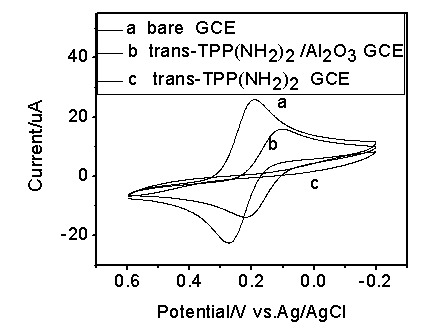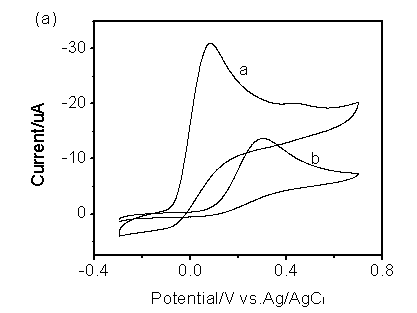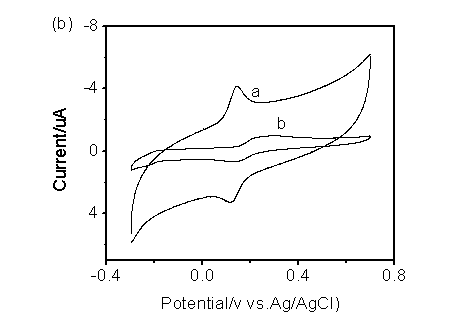Novel use of porphyrin modified electrode
A technology for modifying electrodes and new uses, applied in the field of electrochemical analysis, can solve the problems of poor selectivity and reproducibility of ascorbic acid, dopamine and uric acid, which cannot be detected at the same time
- Summary
- Abstract
- Description
- Claims
- Application Information
AI Technical Summary
Problems solved by technology
Method used
Image
Examples
Embodiment 1
[0026] Polishing treatment of glassy carbon electrode: the glassy carbon electrode is polished into a mirror surface with 0.3 μm and 0.05 μm aluminum oxide suspension in turn, and then ultrasonically cleaned with 95% ethanol and double distilled water in turn to obtain a polished surface. glassy carbon electrode. Determination of the charge transfer resistance value (Rct) of the bare electrode: After the treated glassy carbon electrode was blown dry with nitrogen gas with a purity of 99.99%, it was inserted into 5 mL containing 5 mM potassium ferricyanide probe molecule with a molar concentration of 0.1 M potassium chloride electrolyte solution, and using a three-electrode system with glassy carbon electrode as working electrode, platinum wire as counter electrode, and Ag / AgCl as reference electrode for AC impedance scanning, the obtained figure 2 curve a in
[0027] Rinse the polished glassy carbon electrode with twice distilled water, dry it with nitrogen gas with a purity...
Embodiment 2
[0029] The trans-TPP (NH 2 ) 2 The modified glassy carbon electrode was placed in 1.5mL of 1mM HCl aqueous solution, and then 3mL of 5mM NaNO was added dropwise. 2 aqueous solution, kept at 0°C, protected by nitrogen gas, reacted for 15 minutes, and carried out the second diazotization (during this process, NaNO 2 The dosage should be excessive, so that the trans-TPP(NH 2 ) 2 fully converted to TPP). Take out the glassy carbon electrode, rinse it with absolute ethanol, dry it with nitrogen with a purity of 99.99%, and soak it in 0.1-3 mg / mL ɑ-Al 2 o 3 After about 6 hours in the aqueous solution, rinse with absolute ethanol, twice distilled water, and blow dry with nitrogen with a purity of 99.99%, to obtain TPP / ɑ-Al 2 o 3 Modified glassy carbon electrodes. Insert 5 mL of 0.1 M potassium chloride electrolyte solution containing 5 mM potassium ferricyanide probe molecules, and use a modified glassy carbon electrode as the working electrode, platinum wire as the counter e...
Embodiment 3
[0033] Detection of ascorbic acid (AA), dopamine (DA) and uric acid (UA) at a porphyrin-modified electrode
[0034] The bare glassy carbon electrode and TPP / ɑ-Al 2 o 3 The modified glassy carbon electrode was rinsed with double distilled water, dried with nitrogen gas with a purity of 99.99%, and placed in a phosphate buffer solution (PH=7) of 0.1-0.6mM ascorbic acid (AA). The three-electrode system with platinum wire as the counter electrode and Ag / AgCl as the reference electrode was scanned for cyclic voltammetry. The potential window was -0.3-0.7V, and the scan rate was 100mV / s. Two different cyclic voltammograms were obtained for plotting. Compared, the result is as image 3 As shown, TPP / ɑ-Al 2 o 3 Modified glassy carbon electrode (curve a) and bare glassy carbon electrode (curve b), from image 3 TPP / ɑ-Al can be seen in the 0.1-0.6mM AA oxidation process 2 o 3 Compared with the bare electrode, the peak potential of the modified electrode has shifted by ΔP=220-230m...
PUM
 Login to View More
Login to View More Abstract
Description
Claims
Application Information
 Login to View More
Login to View More - R&D
- Intellectual Property
- Life Sciences
- Materials
- Tech Scout
- Unparalleled Data Quality
- Higher Quality Content
- 60% Fewer Hallucinations
Browse by: Latest US Patents, China's latest patents, Technical Efficacy Thesaurus, Application Domain, Technology Topic, Popular Technical Reports.
© 2025 PatSnap. All rights reserved.Legal|Privacy policy|Modern Slavery Act Transparency Statement|Sitemap|About US| Contact US: help@patsnap.com



